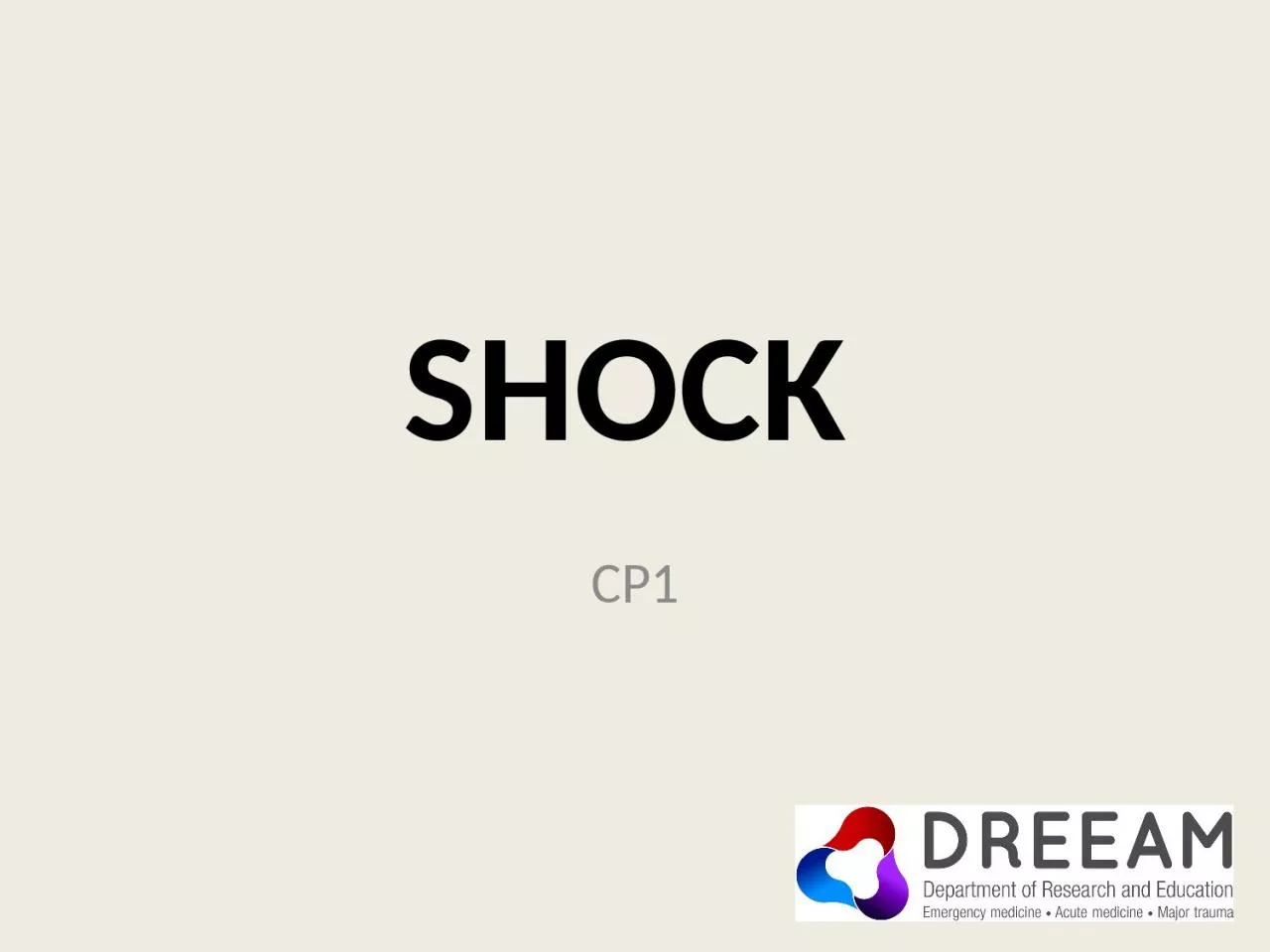

SHOCK The student should be able to TDO Define shock 18b List the types of shock 18b List the causes for each type of shock 18b Contrast the effects of each category of shock on the following organsorgan systems heart kidney brain lung gut immune ID: 1002338
Download Presentation The PPT/PDF document "SHOCK CP1 CP1 Curriculum/ Study Guide Ob..." is the property of its rightful owner. Permission is granted to download and print the materials on this web site for personal, non-commercial use only, and to display it on your personal computer provided you do not modify the materials and that you retain all copyright notices contained in the materials. By downloading content from our website, you accept the terms of this agreement.
1. SHOCKCP1
2. CP1 Curriculum/ Study Guide ObjectivesSHOCKThe student should be able to:TD/ODefine shock.1/8bList the types of shock.1/8bList the causes for each type of shock.1/8bContrast the effects of each category of shock on the following organs/organ systems: heart, kidney, brain, lung, gut, immune.1/8b; 2/16List the physical findings that characterise each kind of shock.1/8bName and briefly describe the monitoring techniques that help in the diagnosis and management of shock.2/16bSkills to be acquired:TD/ORecognise the following:hypoxia, oliguria, hypotension1/14d
3. Learning Objectives Define shock and list the types of shock Understand the physiology relevant to each type of shock Identify case examples that shows physical finding that characterise each type of shockDescribed the monitoring and management of each type of shock
4. What do you know about shock?
5.
6. SHOCK Life threatening failure of oxygen delivery to tissuesA state of cellular and tissue hypoxia
7. Cellular Hypoxia occurs as a result of :Reduced tissue perfusion Reduced oxygen delivery Increased oxygen consumption Inadequate oxygen utilization
8. SHOCKWhich of the patients below is shocked? A B C1208075805015010080120
9. VESSEL LENGTHVESSEL TONE BLOOD VISCOSITYPHYSIOLOGY
10. VESSEL LENGTHVESSEL TONE BLOOD VISCOSITYPHYSIOLOGY
11. VESSEL LENGTHVESSEL TONE BLOOD VISCOSITYPHYSIOLOGY
12. VESSEL LENGTHVESSEL TONE BLOOD VISCOSITYPHYSIOLOGY
13. VESSEL LENGTHVESSEL TONE BLOOD VISCOSITYPHYSIOLOGY
14. HypovolaemicDistributiveCardiogenicObstructiveTYPES OF SHOCK
15. HypovolaemicDistributiveCardiogenicObstructiveSHOCK TYPES v PHYSIOLOGY Some clinical similaritySome clinical similarity
16. HypovolaemicDistributiveCardiogenicObstructiveTYPES OF SHOCK
17. HypovolaemicShock
18. What signs and symptoms do you expect to see in this group of patients?HypovolaemicShock How will you treat?
19. DistributiveShock
20. What are the signs and symptoms?How will you treat?DistributiveShock
21. CardiogenicShock
22. CardiogenicShock What are the signs and symptoms?How will you treat?
23. ObstructiveShock
24. ObstructiveShock What are the signs and symptoms?How will you treat?
25. HypovolaemicDistributiveCardiogenicObstructiveSUB-TYPES OF SHOCK NeurogenicSepticAnaphylacticHaemorrhagic and non haemorrhagic
26. Monitoring in ShockA-E assessment (and regular reassessment)Standard Observations (RR, SpO2, oxygen delivery device, HR, BP, Temp, AVPU)Hourly Urine Output monitoring – Insert urinary catheterUrgent investigations:Blood gas : For lactate, and for acid-base/respiratory statusECG Other bloods : depends on suspected causes
27. Managing Shock Management approach is to correct findings on A- E High-flow (15L) oxygen via a non-rebreathe maskEstablish IV access earlyIV fluid resuscitation (unless obvious Cardiogenic shock)Treat Underlying cause
28. ?
29. Shock- Summary of categories Type of ShockProcessAffects BP viaSome Possible CausesSymptomsManagementDistributiveFailure of VasoregulationSystemic Vascular ResistanceSepsis, Anaphylaxis, Spinal Cord Injury, Traumatic Brain InjuryAltered Mental State, Tachycardia, Hypotension, Tachypnoea, Reduced Urine Output, Prolonged Capillary Refill TimeWarmHigh Flow Oxygen, Treat Underlying CauseFluids, Vasopressors, InotropesHypovolaemicLoss of Intravascular VolumePreloadHaemorrhage, Dehydration, GI LossesCool/MottledFluids, +/- Blood ProductsCardiogenicPump FailureHeart Rate, Compliance, ContractilityArrhythmias, Cardiomyopathy, Myocardial InfarctionChronotropes, Inotropes, VasopressorsObstructiveBlockage of Blood FlowAfterload, Compliance, PreloadAortic Dissection, Cardiac Tamponade, Tension Pneumothorax, Massive Pulmonary EmbolismFluids, Relieve Obstruction
30. Further reading:Moodle CP1- ‘ He is not responding doctor’